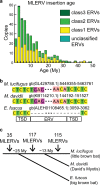Genome-wide characterization of endogenous retroviruses in the bat Myotis lucifugus reveals recent and diverse infections
- PMID: 23720713
- PMCID: PMC3719839
- DOI: 10.1128/JVI.00892-13
Genome-wide characterization of endogenous retroviruses in the bat Myotis lucifugus reveals recent and diverse infections
Abstract
Bats are increasingly recognized as reservoir species for a variety of zoonotic viruses that pose severe threats to human health. While many RNA viruses have been identified in bats, little is known about bat retroviruses. Endogenous retroviruses (ERVs) represent genomic fossils of past retroviral infections and, thus, can inform us on the diversity and history of retroviruses that have infected a species lineage. Here, we took advantage of the availability of a high-quality genome assembly for the little brown bat, Myotis lucifugus, to systematically identify and analyze ERVs in this species. We mined an initial set of 362 potentially complete proviruses from the three main classes of ERVs, which were further resolved into 13 major families and 86 subfamilies by phylogenetic analysis. Consensus or representative sequences for each of the 86 subfamilies were then merged to the Repbase collection of known ERV/long terminal repeat (LTR) elements to annotate the retroviral complement of the bat genome. The results show that nearly 5% of the genome assembly is occupied by ERV-derived sequences, a quantity comparable to findings for other eutherian mammals. About one-fourth of these sequences belong to subfamilies newly identified in this study. Using two independent methods, intraelement LTR divergence and analysis of orthologous loci in two other bat species, we found that the vast majority of the potentially complete proviruses identified in M. lucifugus were integrated in the last ~25 million years. All three major ERV classes include recently integrated proviruses, suggesting that a wide diversity of retroviruses is still circulating in Myotis bats.
Figures




References
-
- Simmons NB. 2005. Order Chiroptera, p 312–529 Wilson DE, Reeder DM. (ed), Mammal species of the world: a taxonomic and geographic reference, 3rd ed, vol 1 Johns Hopkins University Press, Baltimore, MD
-
- Hockman D, Mason MK, Jacobs DS, Illing N. 2009. The role of early development in mammalian limb diversification: a descriptive comparison of early limb development between the Natal long-fingered bat (Miniopterus natalensis) and the mouse (Mus musculus). Dev. Dyn. 238:965–979 - PubMed
-
- Munshi-South J, Wilkinson GS. 2010. Bats and birds: exceptional longevity despite high metabolic rates. Ageing Res. Rev. 9:12–19 - PubMed
Publication types
MeSH terms
Grants and funding
LinkOut - more resources
Full Text Sources
Other Literature Sources
Miscellaneous

